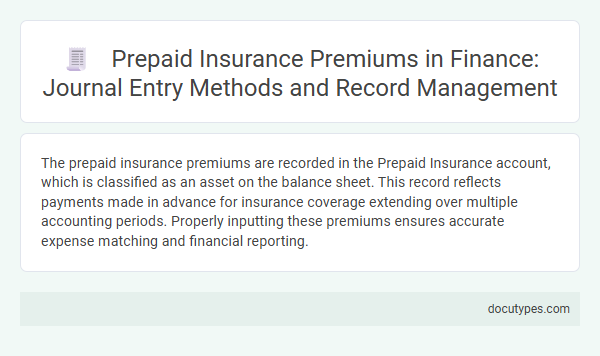The prepaid insurance premiums are recorded in the Prepaid Insurance account, which is classified as an asset on the balance sheet. This record reflects payments made in advance for insurance coverage extending over multiple accounting periods. Properly inputting these premiums ensures accurate expense matching and financial reporting.
Overview of Prepaid Insurance Premiums in Finance
Prepaid insurance premiums represent payments made in advance for insurance coverage extending over multiple accounting periods. Properly recording these premiums ensures accurate financial statements and expense matching in your accounting records.
- Prepaid Insurance Account - This asset account records the amount paid for insurance coverage yet to be consumed.
- Journal Entry for Payment - Debit prepaid insurance and credit cash or accounts payable when the premium is paid.
- Expense Recognition - Monthly adjusting entries transfer the appropriate portion from prepaid insurance to insurance expense.
Importance of Accurate Prepaid Insurance Accounting
Accurate recording of prepaid insurance premiums is essential for precise financial reporting and expense management. Using the correct accounting record ensures that insurance costs are allocated over the appropriate periods.
- Prepaid Insurance Account - This asset account is used to input prepaid insurance premiums reflecting payments made in advance.
- Adjusting Entries - These entries allocate the prepaid insurance cost to the expense account as coverage periods elapse.
- Trial Balance Verification - Ensures that the prepaid insurance amounts are correctly stated and matched with corresponding liabilities or expenses.
Maintaining accurate prepaid insurance records improves budgeting accuracy and compliance with accounting standards.
Initial Journal Entry for Prepaid Insurance
The initial journal entry for prepaid insurance involves recording the prepaid insurance premium as an asset on the balance sheet. This entry reflects the payment made in advance for insurance coverage over a future period.
The prepaid insurance account is debited to recognize the asset, while the cash or bank account is credited to record the payment. This accounting treatment ensures accurate matching of expenses and recognition of insurance cost over the coverage period.
Adjusting Entries for Expired Insurance Premiums
Prepaid insurance premiums are initially recorded as assets in the Prepaid Insurance account. Adjusting entries are made to allocate the expired portion of these premiums as insurance expense over the coverage period.
- Prepaid Insurance Account - Used to record the payment of insurance premiums before the coverage period begins, reflecting an asset on the balance sheet.
- Adjusting Entry for Expired Premiums - At the end of the accounting period, a portion of the prepaid insurance is transferred from the asset to an expense to represent the cost of insurance used.
- Insurance Expense Account - Recognizes the cost associated with the expired portion of prepaid insurance, impacting the income statement during the adjustment.
Impact of Prepaid Insurance on Financial Statements
```htmlPrepaid insurance premiums are recorded as an asset under the prepaid expenses account on the balance sheet. This record represents payments made in advance for insurance coverage extending over future periods.
As the insurance coverage period progresses, the prepaid insurance balance decreases and insurance expense is recognized on the income statement. This adjustment impacts net income by matching expense recognition with the related coverage period, ensuring accurate financial reporting.
```Common Methods for Recording Prepaid Insurance
| Record Type | Description | Purpose |
|---|---|---|
| Prepaid Insurance Account | A current asset account used to record the cost of insurance premiums paid in advance. | To track the amount of insurance coverage purchased but not yet consumed. |
| Journal Entry | Debit Prepaid Insurance and credit Cash or Accounts Payable at the time of payment. | To recognize the payment of insurance premiums before the coverage period begins. |
| Adjusting Entry | Debit Insurance Expense and credit Prepaid Insurance monthly or periodically. | To allocate the prepaid premium to the appropriate expense account over the coverage period. |
You should record prepaid insurance premiums initially by debiting the Prepaid Insurance account to reflect the asset and crediting your Cash or Accounts Payable account. Over time, adjust the balances to recognize insurance expenses systematically.
Best Practices for Record Management of Insurance Premiums
The prepaid insurance premiums are recorded in the prepaid insurance account, an asset on the balance sheet. Best practices for managing these records include maintaining detailed documentation of payment dates, coverage periods, and amounts to ensure accurate amortization. Consistent reconciliation of prepaid insurance entries with insurance policy terms helps prevent discrepancies and supports financial transparency.
Internal Controls for Prepaid Insurance Accounts
Which record is used to input prepaid insurance premiums? The prepaid insurance account record is utilized to initially record the payment of insurance premiums. Maintaining accurate entries in this record is essential for internal controls over prepaid insurance accounts.
How do internal controls protect prepaid insurance accounts? Segregation of duties ensures that different individuals handle the recording and authorization of prepaid insurance transactions. Regular reconciliations of the prepaid insurance ledger help detect discrepancies or unauthorized adjustments, strengthening your financial accuracy.
Common Errors in Prepaid Insurance Journal Entries
The prepaid insurance premiums are recorded using the Prepaid Insurance account, which is an asset account on the balance sheet. Common errors in prepaid insurance journal entries include incorrectly debiting Insurance Expense instead of Prepaid Insurance and failing to adjust the prepaid balance for the expired portion of the insurance coverage. Accurate entries ensure proper matching of expenses with the period they benefit, maintaining financial statement integrity.
Which Record Is Used to Input Prepaid Insurance Premiums? Infographic

